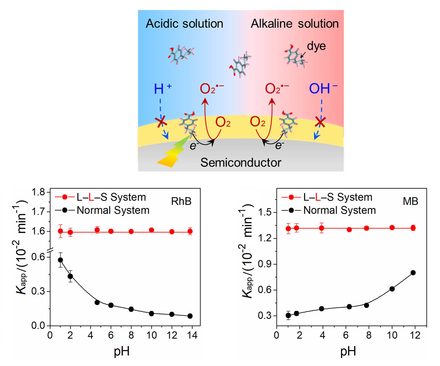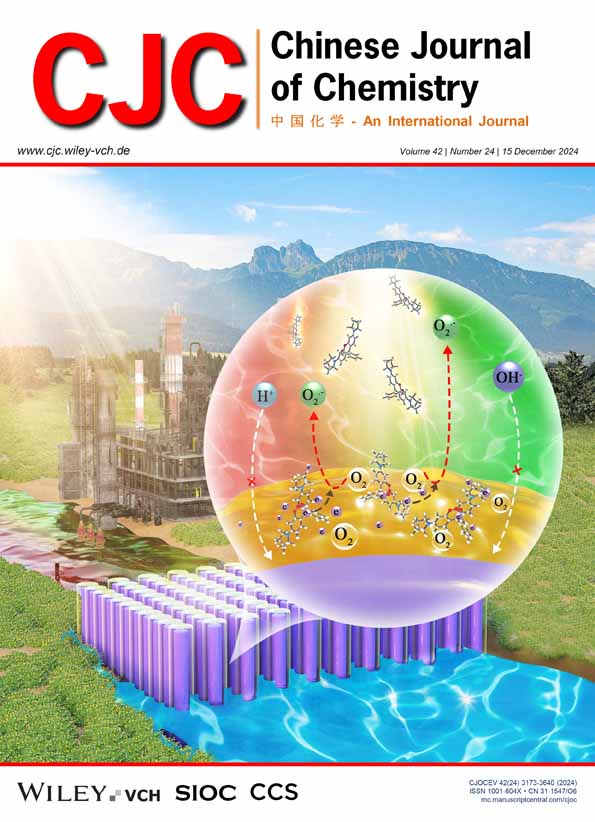pH Independent and Efficient Photocatalytic Systems Enabled by Reaction Interface Microenvironment Regulation†
Hang Zhou
College of Chemistry, Chemical Engineering and Materials Science, Soochow University, Suzhou, Jiangsu, 215123 China
Search for more papers by this authorCorresponding Author
Xia Sheng
College of Chemistry, Chemical Engineering and Materials Science, Soochow University, Suzhou, Jiangsu, 215123 China
E-mail: [email protected]; [email protected]Search for more papers by this authorXi Chen
College of Chemistry, Chemical Engineering and Materials Science, Soochow University, Suzhou, Jiangsu, 215123 China
Search for more papers by this authorZhiping Liu
College of Chemistry, Chemical Engineering and Materials Science, Soochow University, Suzhou, Jiangsu, 215123 China
Search for more papers by this authorCorresponding Author
Xinjian Feng
College of Chemistry, Chemical Engineering and Materials Science, Soochow University, Suzhou, Jiangsu, 215123 China
Suzhou Institute for Advanced Research, University of Science and Technology of China, Suzhou, Jiangsu, 215123 China
E-mail: [email protected]; [email protected]Search for more papers by this authorHang Zhou
College of Chemistry, Chemical Engineering and Materials Science, Soochow University, Suzhou, Jiangsu, 215123 China
Search for more papers by this authorCorresponding Author
Xia Sheng
College of Chemistry, Chemical Engineering and Materials Science, Soochow University, Suzhou, Jiangsu, 215123 China
E-mail: [email protected]; [email protected]Search for more papers by this authorXi Chen
College of Chemistry, Chemical Engineering and Materials Science, Soochow University, Suzhou, Jiangsu, 215123 China
Search for more papers by this authorZhiping Liu
College of Chemistry, Chemical Engineering and Materials Science, Soochow University, Suzhou, Jiangsu, 215123 China
Search for more papers by this authorCorresponding Author
Xinjian Feng
College of Chemistry, Chemical Engineering and Materials Science, Soochow University, Suzhou, Jiangsu, 215123 China
Suzhou Institute for Advanced Research, University of Science and Technology of China, Suzhou, Jiangsu, 215123 China
E-mail: [email protected]; [email protected]Search for more papers by this author† Dedicated to the Special Issue of Biomimetic Materials.
Comprehensive Summary
Photocatalysis is a promising green approach for water purification. The diversity of water pH values is a key factor that restricts its practical application since pH affects the adsorption of organic molecules, the stability of catalysts and photocatalytic performance. Here, we report a pH–independent, efficient and stable photocatalytic system with a liquid (water)–liquid (oil)–solid (semiconductor) (L–L–S) triphase interface microenvironment. The system is fabricated by coating a thin layer of silicon oil on the surface of ZnO nanowire arrays, a model chemically unstable semiconductor in both acidic and alkaline solutions. We show that the unique interface makes the dye adsorption pH independent and prevents the semiconductor from being corroded by strong acidic/alkaline solutions, leading to a stable and efficient photocatalytic reaction over a wide pH range (1—14). These findings reveal a promising path for the development of high-performance catalysis systems applicable in complex water environments.

Supporting Information
| Filename | Description |
|---|---|
| cjoc202400618-sup-0001-supinfo.pdfPDF document, 1.3 MB |
Appendix S1: Supporting Information |
Please note: The publisher is not responsible for the content or functionality of any supporting information supplied by the authors. Any queries (other than missing content) should be directed to the corresponding author for the article.
References
- 1(a) Ma, Q.; Yu, Y.; Sindoro, M.; Fane, A. G.; Wang, R.; Zhang, H. Carbon-based functional materials derived from waste for water remediation and energy storage. Adv. Mater. 2017, 29, 1605361; (b) Fukuda, S.; Noda, K.; Oki, T. How global targets on drinking water were developed and achieved. Nat. Sustain. 2019, 2, 429–434; (c) Martínez-Huitle, C. A.; Rodrigo, M. A.; Sirés, I.; Scialdone, O. A critical review on latest innovations and future challenges of electrochemical technology for the abatement of organics in water. Appl. Catal., B 2023, 328, 122430.
- 2(a) Guo, Q.; Zhou, C.; Ma, Z.; Yang, X. Fundamentals of TiO2 photocatalysis: Concepts, mechanisms, and challenges. Adv. Mater. 2019, 31, 1901997; (b) Luo, J.; Zhang, S.; Sun, M.; Yang, L.; Luo, S.; Crittenden, J. C. A critical review on energy conversion and environmental remediation of photocatalysts with remodeling crystal lattice, surface, and interface. ACS Nano 2019, 13, 9811–9840; (c) Miao, Y.; Zhao, Y.; Zhang, S.; Shi, R.; Zhang, T. Strain engineering: A boosting strategy for photocatalysis. Adv. Mater. 2022, 34, 2200868; (d) Xu, L.; Wong, P. K.; Jiang, Z.; Yu, J. C. Iodide-mediated selective photocatalytic treatment of phenolic pollutants. Appl. Catal., B 2023, 338, 123080.
- 3(a) Wang, G.; Zhang, Q.; Chen, Q.; Ma, X.; Xin, Y.; Zhu, X.; Ma, D.; Cui, C.; Zhang, J.; Xiao, Z. Photocatalytic degradation performance and mechanism of dibutyl phthalate by graphene/TiO2 nanotube array photoelectrodes. Chem. Eng. J. 2019, 358, 1083–1090; (b) Moradi, M.; Hasanvandian, F.; Isari, A. A.; Hayati, F.; Kakavandi, B.; Setayesh, S. R. CuO and ZnO co-anchored on g-C3N4 nanosheets as an affordable double Z-scheme nanocomposite for photocatalytic decontamination of amoxicillin. Appl. Catal., B 2021, 285, 119838; (c) Berkani, M.; Smaali, A.; Kadmi, Y.; Almomani, F.; Vasseghian, Y.; Lakhdari, N.; Alyane, M. Photocatalytic degradation of Penicillin G in aqueous solutions: Kinetic, degradation pathway, and microbioassays assessment. J. Hazard. Mater. 2022, 421, 126719; (d) Gondar, D.; López, R.; Antelo, J.; Fiol, S.; Arce, F. Effect of organic matter and pH on the adsorption of metalaxyl and penconazole by soils. J. Hazard. Mater. 2013, 260, 627–633; (e) Wang, Y.; Zheng, Y. Z.; Lu, S.; Tao, X.; Che, Y.; Chen, J. F. Visible-light-responsive TiO2-coated ZnO:I nanorod array films with enhanced photoelectrochemical and photocatalytic performance. ACS Appl. Mater. Interfaces 2015, 7, 6093–6101; (f) Lv, Y.; Zhang, C.; He, A.; Yang, S. J.; Wu, G.-P.; Darling, S. B.; Xu, Z. K. Photocatalytic nanofiltration membranes with self-cleaning property for wastewater treatment. Adv. Funct. Mater. 2017, 27, 1700251; (g) Zhao, M.; Xu, H.; Ouyang, S.; Tong, H.; Chen, H.; Li, Y.; Song, L.; Ye, J. Fabricating a Au@TiO2 plasmonic system to elucidate alkali-induced enhancement of photocatalytic H2 evolution: Surface potential shift or methanol oxidation acceleration? ACS Catal. 2018, 8, 4266–4277.
- 4(a) Feng, X.; Jiang, L. Design and creation of superwetting/antiwetting surfaces. Adv. Mater. 2006, 18, 3063–3078; (b) Su, B.; Tian, Y.; Jiang, L. Bioinspired interfaces with superwettability: From materials to chemistry. J. Am. Chem. Soc. 2016, 138, 1727–1748; (c) Fu, Q.; Bao, X. Confined microenvironment for catalysis control. Nat. Catal. 2019, 2, 834–836; (d) Wu, Y.; Feng, J.; Gao, H.; Feng, X.; Jiang, L. Superwettability-based interfacial chemical reactions. Adv. Mater. 2019, 31, 1800718; (e) Xu, M.; Li, D.; Sun, K.; Jiao, L.; Xie, C.; Ding, C.; Jiang, H. L. Interfacial microenvironment modulation boosting electron transfer between metal nanoparticles and MOFs for enhanced photocatalysis. Angew. Chem. Int. Ed. 2021, 60, 16372–16376.
- 5(a) Lei, Y.; Sun, R.; Zhang, X.; Feng, X.; Jiang, L. Oxygen-rich enzyme biosensor based on superhydrophobic electrode. Adv. Mater. 2016, 28, 1477–1481;
(b) Mi, L.; Yu, J.; He, F.; Jiang, L.; Wu, Y.; Yang, L.; Han, X.; Li, Y.; Liu, A.; Wei, W.; Zhang, Y.; Tian, Y.; Liu, S.; Jiang, L. Boosting gas involved reactions at nanochannel reactor with joint gas–solid–liquid interfaces and controlled wettability. J. Am. Chem. Soc. 2017, 139, 10441–10446;
(c) Sheng, X.; Liu, Z.; Zeng, R.; Chen, L.; Feng, X.; Jiang, L. Enhanced photocatalytic reaction at air–liquid–solid joint interfaces. J. Am. Chem. Soc. 2017, 139, 12402-12405;
(d) Li, J.; Chen, G.; Zhu, Y.; Liang, Z.; Pei, A.; Wu, C. L.; Wang, H.; Lee, H. R.; Liu, K.; Chu, S.; Cui, Y. Efficient electrocatalytic CO2 reduction on a three- phase interface. Nat. Catal. 2018, 1, 592–600;
(e) Wang, Z.; Chen, L.; Wang, D.; Ding, Z.; Zhang, X.; Feng, X.; Jiang, L. High-performance photocathodic bioanalysis based on core–shell structured Cu2O@TiO2 nanowire arrays with air–liquid–solid joint interfaces. CCS Chem. 2021, 4, 1044–1053;
10.31635/ccschem.021.202100842 Google Scholar(f) He, F.; Weon, S.; Jeon, W.; Chung, M. W.; Choi, W. Self-wetting triphase photocatalysis for effective and selective removal of hydrophilic volatile organic compounds in air. Nat. Commun. 2021, 12, 6259.
- 6(a) Faber, M. S.; Dziedzic, R.; Lukowski, M. A.; Kaiser, N. S.; Ding, Q.; Jin, S. High-performance electrocatalysis using metallic cobalt pyrite (CoS2) micro- and nanostructures. J. Am. Chem. Soc. 2014, 136, 10053–10061; (b) Lu, Z.; Sun, M.; Xu, T.; Li, Y.; Xu, W.; Chang, Z.; Ding, Y.; Sun, X.; Jiang, L. Superaerophobic electrodes for direct hydrazine fuel cells. Adv. Mater. 2015, 27, 2361–2366; (c) Meng, X.; Zhan, Q.; Wu, Y.; Zhu, M.; Liu, K.; Wang, N.; Yin, K.; Sun, Y.; Dong, S.; Dai, Y. Aligning Fe2O3 photo-sheets on TiO2 nanofibers with hydrophilic and aerophobic surface for boosting photoelectrochemical performance. Nano Res. 2023, 16, 4178–4187.
- 7 Zhang, J.; Sheng, X.; Cheng, X.; Chen, L.; Jin, J.; Feng, X. Robust electrochemical metal oxide deposition using an electrode with a superhydrophobic surface. Nanoscale 2017, 9, 87–90.
- 8(a) Wong, T. S.; Kang, S. H.; Tang, S. K. Y.; Smythe, E. J.; Hatton, B. D.; Grinthal, A.; Aizenberg, J. Bioinspired self-repairing slippery surfaces with pressure-stable omniphobicity. Nature 2011, 477, 443–447;
(b) Zuo, Y.; Zheng, L.; Zhao, C.; Liu, H. Micro-/nanostructured interface for liquid manipulation and its applications. Small 2020, 16, 1903849;
(c) Leng, X.; Sun, L.; Long, Y.; Lu, Y. Bioinspired superwetting materials for water manipulation. Droplet 2022, 1, 139–169;
10.1002/dro2.29 Google Scholar(d) Si, Y.; Li, C.; Hu, J.; Zhang, C.; Dong, Z. Bioinspired superwetting open microfluidics: from concepts, phenomena to applications. Adv. Funct. Mater. 2023, 33, 2301017.
- 9(a) Zhao, W.; Sun, Y.; Castellano, F. N. Visible-light induced water detoxification catalyzed by PtII dye sensitized titania. J. Am. Chem. Soc. 2008, 130, 12566–12567; (b) Chen, C.; Ma, W.; Zhao, J. Semiconductor-mediated photodegradation of pollutants under visible- light irradiation. Chem. Soc. Rev. 2010, 39, 4206–4219; (c) Lang, X.; Chen, X.; Zhao, J. Heterogeneous visible light photocatalysis for selective organic transformations. Chem. Soc. Rev. 2014, 43, 473–486.
- 10 Zhou, H.; Sheng, X.; Ding, Z.; Chen, X.; Zhang, X.; Feng, X.; Jiang, L. Liquid–Liquid–Solid triphase interface microenvironment mediates efficient photocatalysis. ACS Catal. 2022, 12, 13690–13696.
- 11 Zhou, H.; Sheng, X.; Xiao, J.; Ding, Z.; Wang, D.; Zhang, X.; Liu, J.; Wu, R.; Feng, X.; Jiang, L. Increasing the efficiency of photocatalytic reactions via surface microenvironment engineering. J. Am. Chem. Soc. 2020, 142, 2738–2743.
- 12(a) Tripathy, N.; Ahmad, R.; Kuk, H.; Hahn, Y. B.; Khang, G. Mesoporous ZnO nanoclusters as an ultra-active photocatalyst. Ceram. Int. 2016, 42, 9519–9526; (b) Yu, F.; Tian, F.; Zou, H.; Ye, Z.; Peng, C.; Huang, J.; Zheng, Y.; Zhang, Y.; Yang, Y.; Wei, X.; Gao, B. ZnO/biochar nanocomposites via solvent free ball milling for enhanced adsorption and photocatalytic degradation of methylene blue. J. Hazard. Mater. 2021, 415, 125511.
- 13(a) Wang, S.; Zhou, Y.; Han, S.; Wang, N.; Yin, W.; Yin, X.; Gao, B.; Wang, X.; Wang, J. Carboxymethyl cellulose stabilized ZnO/biochar nanocomposites: Enhanced adsorption and inhibited photocatalytic degradation of methylene blue. Chemosphere 2018, 197, 20–25; (b) Murugan, P.; Ramar, P.; Mandal, A. B.; Samanta, D. Investigating the photocatalytic performances of nanocomposites containing narrow- band-gap copolymers and ZnO. ChemistrySelect 2019, 4, 14214–14221.
- 14 Sun, C.; Wang, M.; Feng, Q.; Liu, W.; Xu, C. Surface-enhanced Raman scattering (SERS) study on Rhodamine B adsorbed on different substrates. Russ. J. Phys. Chem. A 2015, 89, 291–296.
15 December 2024
Pages 3349-3354




